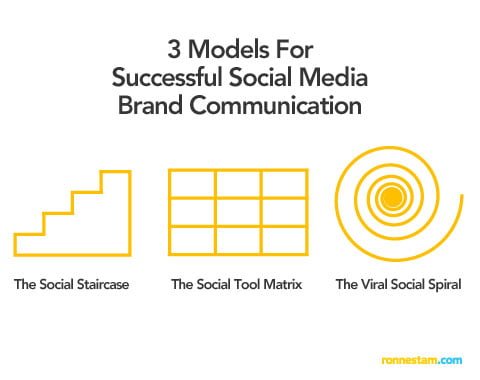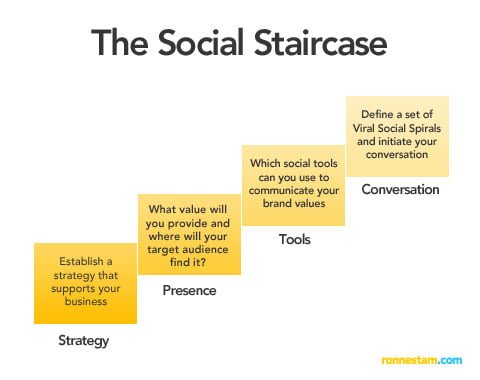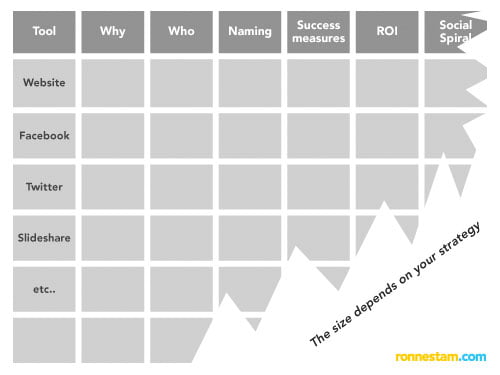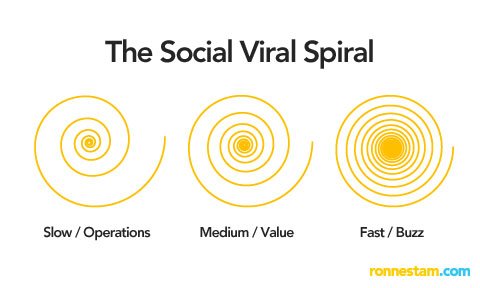Think social media and conversational marketing might be the next train to heaven for your brand but don’t know where to board? Well, here’s three social media marketing models that will make sure you’ll find your station.
If you wanna get moving into the social country of love where conversation rules you’ve gotta get one thing straight. Valuable content is king. Buying a loudspeaker and start tweeting wont get you anywhere. Swedish brands like Comhem and Boxer have effectively proven that just twittering the 140 sign language doesn’t earn you any followers. Every social network will provide you with it’s own possibilities and traps. A well executed strategy is a must or you’ll end up in a minefield.
Here are 3 models by Johan Ronnestam that will guide your brand towards a successful social media strategy.

3 Models That Will Guide You Into The Social Media Landscape
-
The Social Staircase
The Social Staircase is a model that focus on the overall process. It’s the stuff that pays for your ticket to love.
-
The Social Tool Matrix
Now you know what kind of presence your business needs. Now it’s time to map the tools to make sure you know what to keep your mouth shut, when to speak and when to listen.
-
The Social Viral Spiral
This is about speed. Spread that love I’m talking about below. But make sure you do it with finesse and timing. Create a couple of Social Viral Spirals and you’re ready to make out!
How your brand makes good use these three models is entirely up to you. When I’m working with brands within this area I off course spend quite a lot of energy and time on getting it right. But hopefully it will be of value for you without my help. Here we go:
1. Get your strategy right with the Social Staircase

The Social Staircase consists out of 4 steps that guides your brand into the conversation landscape called Social Media
I have outlined 4 steps that make up the Social Staircase. These are the ones I’d suggest you’d use too when you wanna move into the social room.
- Step 1 -Strategy
Establish a strategy that supports your business. Whatever you do in life you should have a strategy in place that supports your business. In other words this means you should strive to achieve your vision, your goals and making sure you don’t loose money while doing it. This should be your approach to social media initiatives too.You should of course be prepared to risk money since it’s still an early adoption initiative. But still you should strive to measure results and revenues. Sooner or later your boss will ask you what he’s paying for and then that answer should be well prepared.
- Step 2 – Presence
The mother of all conversions is content. Think about it – when you’re at a party, how long do you think your conversation would last if you didn’t provide any true value. Bullshit or merely staying quiet wont earn you any new friends. Of course some people you’ve known since way back will stay put but sooner or later even them will stop inviting you to their party.
I haven’t bothered to create any models for this step. It’s a simple rule. Think about you and your business. What value can you provide people with and in what format? Blogs, Video, Photos, Podcasts, Livestreams, Advisory, Games, Knowledge etc. Based on your strategy in step 1 – what kind of value can you provide your target group and potential fans with? Cause that should always be your goal – turning people into fans! If you’ve done your homework this should work like a charm.
If you’re looking for inspirations. Head over to the Social Media Wiki. - Step 3 – Tools
Ok. So know you know that kind of presence you’re after. Then it’s time to gear up. Facebook, Twitter, Slideshare, WordPress, LinkedIn, Scribd, Google Buzz might be the obvious ones. But dig deeper – there’s something for everyone out there and you should consider where your content will do the boogaloo at it’s best!Tools defined? Then move on and figure out when to run with it and when to slow down. Move over to the conversation step, create a set of social viral spirals and get down to business.
- Step 4 – Conversation
Listen. Talk back. Listen. Talk back. Listen. Talk…This is what a conversation is all about. We could actually call it interactivity. You create valuable content and then once you let it out in the open – listen and learn how to fine tune those spirals of yours.
(I’ve posted stuff before on the listening part and so have others – that’s of course crucial in this phase. Since neither me or them have posted a tip on Silverbakk then here it is.)
You should avoid creating to many spirals. They will only confuse you. But on the other hand if you got to few you might not hit the right spots. After all, segmentation has been around for ages and it’s not for the fun of it. Segmenting who and how to target your audience is essential.
Let’s move on and a have a look at the Social Tool Matrix.
2. What content goes where – Outline your tactical tools with a Social Tool Matrix

It’s all about structure, planning, organization and control (once you have something to say)
Don’t pick any tool out there for the fun of it and definitely don’t let one person in your organization handle them all. Every tool has it’s own advantages and should be treated that way.
Once you’ve passed the strategy and presence step in the Social Staircase it’s time to map which tools can do the work for you. It’s now time to create a Social Tool Matrix.
The Social Tool Matrix basically makes sure you and your organization analyze and choose a set of social tools that can deliver on strategy. While you’re entering stuff into the matrix you’ll be forced to answer the following questions:
- What tools shall we use to fulfill our strategy?
Choose your tools carefully. Just because your competitor is riding the wave over at Facebook doesn’t mean you should. Look back at the social staircase. What strategy and what presence should you support? - Why should we use this tool?
Publish, interact, spread, buzz, images, video etc. Remember that sometimes you’ll be better off with more than one tool doing the same thing. Video for example. YouTube, Viddler and Vimeo are all about video but have different advantages. - Who should be responsible for the updates?
Don’t drop the entire load on top of a webmaster. Make sure your social marketing is spread out horizontally on your organization. The right person for the job huh? - What’s the naming / domain conventions?
I use ‘ronnestam’ everywhere I can. What’s your strategy? Think before you act and then keep track of it! - When can we say we’re successful?
This is a hard one. People that comment your blog posts. Diggs. Linkups. Facebook recommendations. Re-tweets. SEO effects. Actual sales. You pick your own index but make sure to pick a couple. Both qualitative and quantitative cause they’re both important. - Can we measure the return of investment (ROI)
If success was hard this is pretty darn impossible when it comes to social media. Some of you might say it’s not. But isolation of social media effects are hard. One of the few examples I know of is Dells Twitter outlet and that’s pretty unique. - What social spiral shall we use (this will be defined in the next stage)
You’re not here yet. But once you get to the next stage of this post. That’s when you decide on the social spirals. Every time you activate a tool. Remember what and what good it does. The Social Spirals will lead the way! - And whatever more you think should go into the matrix.
Last but not least. This post is inspirational – not an actual guide. You have to do your homework and your business might need a lot more inside the matrix than my actual example. Get it right and you shall succeed!
Once you got the social matrix mapped you and everyone in your organization is prepared to start the conversation it’s time for one last thing – the Social Viral Spirals.
3. Get viral with the Social Viral Spiral

Choose your tools wisely and start a conversation
Many of you have of course seen Brian Solis Social Conversation Prism.I love it too but it’s more of a wonderful image that maps all the possibilities with the social web than help for brands who are trying to figure out what to do and where to do it. Of course you can do everything and in some cases maybe you should. But what you really need once you’ve got an idea what you can do is a tactical tool.
I’ve created the The Social Viral Spiral for exactly that purpose. Use Brian Solis Prism and then translate the tools and services you need and create your own set of Social Flowers depending on what you are trying to achieve.
What the Social Spiral does is basically define where, what, how and when you should seed that content of yours into the social web. Triggering conversations online must start somewhere and then continue over a series of social networks and tools depending on what your purpose is. Marketing campaigns are in need of a lightning speed spread. Corporate information might not need that spread at all but still needs to go social due to SEO reasons for example.
A brand or company can have as many spirals as they want but I personally think you should aim for 3 or 4 depending on what kind of product and services your brand produce. The purpose of these spirals differ depending on a set of factors and you will probably have to adjust them over time.

Once you’ve got an idea on what kind of content and activities should be matched with a certain spiral you will surely have better chances in succeeding and most importantly you will have moved the knowledge about conversation from a specific employee to your organization!
Things that affect the intensity/speed of your spirals.
- Type of content
- Timezones
- Time of actual publishing
- Internet behavioral patterns
- Where did you act the last time
- Number of followers on Twitter
- Number of friends in social networks
- Amount of social networks where you intend to interact
- How unique is the content you intend to promote
- What brand do you represent?
- Purpose – marketing, operations, news, etc…
Got that wired? Good. Then it’s all about creating that content and spin the wheel.
Right now you might have tons of open questions about this post OR it seems perfectly clear. I really don’t care which since I’ve gotta get this thing published before it consumes me.
Best of luck!